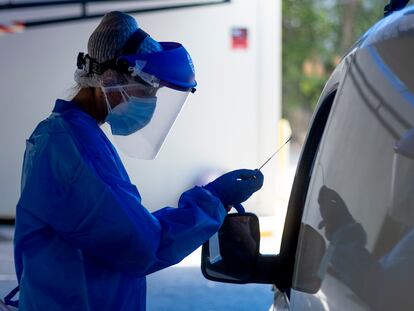Coronavirus infections continue to rise in Spain, with nearly 3,000 reported in 24 hours
The daily increase is the highest seen since the end of April, but heath official Fernando Simón sought to play down the figures at a press conference on Thursday


With three in every 10 of the new coronavirus infections diagnosed in the last 24 hours, Madrid is the Spanish region that most accounted for the significant rise in cases that was reported on Thursday evening by the Health Ministry. In total, the country’s regional governments informed the central administration of 2,935 positives detected the day before, which is 1,000 more than the record figure seen since the deescalation of confinement measures: on August 7, a total of 1,895 new cases were reported.
Not since the end of April has such a rise been seen – although at that point, there was no distinction in the statistics supplied by the ministry between new cases and cases diagnosed the day before. Despite this, Fernando Simón, the director of the Health Ministry’s Coordination Center for Health Alerts (CCAES), played down the high figures during his twice-weekly press conference. “It’s a gentle rise that allows for the implementation of control measures,” he said. “The percentage of asymptomatic [cases] is very high, over 50%, and we are detecting a lot of cases very early,” he added.
It’s a gentle rise that allows for the implementation of control measuresFernando Simón, director of the Health Ministry’s Coordination Center for Health Alerts
Thursday’s figures saw Madrid report 842 cases, the Basque Country 545 and Aragón 418. These were infections that were diagnosed the previous day, meaning that the lack of data supplied by Madrid on Wednesday due to “technical problems” had no effect on the figure. Where this was noticeable was in the rise in daily cases, the figure that is produced by subtracting the total infections reported on Thursday (337,334) from the total on the previous day (329,784). The result is 7,550 new infections added in a day, which includes those diagnosed the day before as well as on previous days and whose notification within the centralized Health Ministry system was delayed. Madrid alone accounted for 3,146 of these cases, having supplied two days’ worth of figures.
Simón explained on Thursday that Catalonia and Aragón are managing to stabilize infections and are even managing to reduce the number of cases in places that have been hard hit by new contagions, such as Lleida. On the other hand, other regions, such as “Valencia and Madrid,” are seeing “gentle and progressive” rises, he explained. “Right now we are doing things well,” he continued. “It is true that it is causing us problems to explain this rises that we are observing. They are real, but at the same time a large part of this rise is also due to a significant rise in our capacity to diagnose [cases].”
As Simón has done in recent days, he praised the management of the regions in the fight against the virus. “Aragón and Catalonia have shown that outbreaks can clearly be controlled,” he said. The two regions could “serve as a mirror” for those that are facing large outbreaks or uncontrolled community transmission in a certain area, he explained. Madrid, Simón added, is one of the regions “on which we most need to focus right now.”
The 14-day cumulative incidence of the virus is at 100 cases per 100,000 inhabitants, rate that is currently only exceeded by Luxembourg in Europe
Simón pointed out once again that there is a large range in the percentages of asymptomatic cases that regions are detecting – the higher the percentage, in general, the better the job of contact tracing and monitoring is being done. However, he did not supply the data for this by region. When he did so last week and gave the figure for asymptomatic cases detected in Madrid, which was a relatively low 15%, regional leaders called him “disloyal” and claimed that the figure was incorrect, later modifying a report from their own public health department that confirmed the figure that Simón had cited.
The cumulative incidence of the virus over 14 days, the indicator that international organizations use to compare the epidemiological situation across countries, came in at 100 cases per 100,000 inhabitants on Thursday in Spain, a rate that is currently only exceeded by Luxembourg in Europe. France, with 32, and Germany, with 15, have much lower rates.
There is a major difference between regions, according to the latest figures. Aragón reported 573 cases per 100,000 inhabitants, the Basque Country 181, and Asturias and the Canary Islands 26. Simón said on Thursday that infections need to be lowered as much as possible before September arrives. “It’s a moment of risk because people who have been in different groups are going to mix once more,” he explained, in reference to the reopening of schools, which were closed back in March, and the return to work for many after the summer break. The CCAES director said that classrooms must be reopened, and that if the situation requires it, specific classes or schools will be closed rather than a blanket closure as was seen earlier in the year.
The Health Ministry also reported 953 hospitalizations in the last seven days, and 71 intensive care unit (ICU) admissions in the same time period. “Currently there are 3,596 beds occupied by patients with coronavirus or who are suspected of having it, with 383 of them in intensive care,” Simón explained. The report also detailed that 70 people had died in Spain after testing positive for the coronavirus in the last seven days.
English version by Simon Hunter.
Tu suscripción se está usando en otro dispositivo
¿Quieres añadir otro usuario a tu suscripción?
Si continúas leyendo en este dispositivo, no se podrá leer en el otro.
FlechaTu suscripción se está usando en otro dispositivo y solo puedes acceder a EL PAÍS desde un dispositivo a la vez.
Si quieres compartir tu cuenta, cambia tu suscripción a la modalidad Premium, así podrás añadir otro usuario. Cada uno accederá con su propia cuenta de email, lo que os permitirá personalizar vuestra experiencia en EL PAÍS.
¿Tienes una suscripción de empresa? Accede aquí para contratar más cuentas.
En el caso de no saber quién está usando tu cuenta, te recomendamos cambiar tu contraseña aquí.
Si decides continuar compartiendo tu cuenta, este mensaje se mostrará en tu dispositivo y en el de la otra persona que está usando tu cuenta de forma indefinida, afectando a tu experiencia de lectura. Puedes consultar aquí los términos y condiciones de la suscripción digital.
More information
Últimas noticias
Most viewed
- Sinaloa Cartel war is taking its toll on Los Chapitos
- Oona Chaplin: ‘I told James Cameron that I was living in a treehouse and starting a permaculture project with a friend’
- Reinhard Genzel, Nobel laureate in physics: ‘One-minute videos will never give you the truth’
- Why the price of coffee has skyrocketed: from Brazilian plantations to specialty coffee houses
- Silver prices are going crazy: This is what’s fueling the rally










































